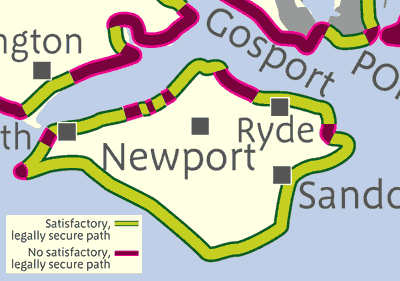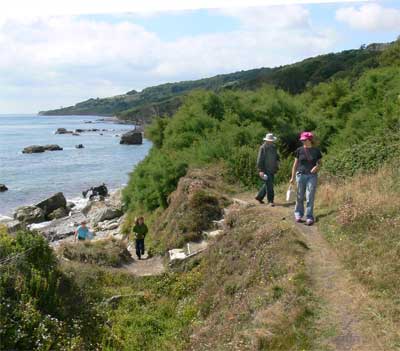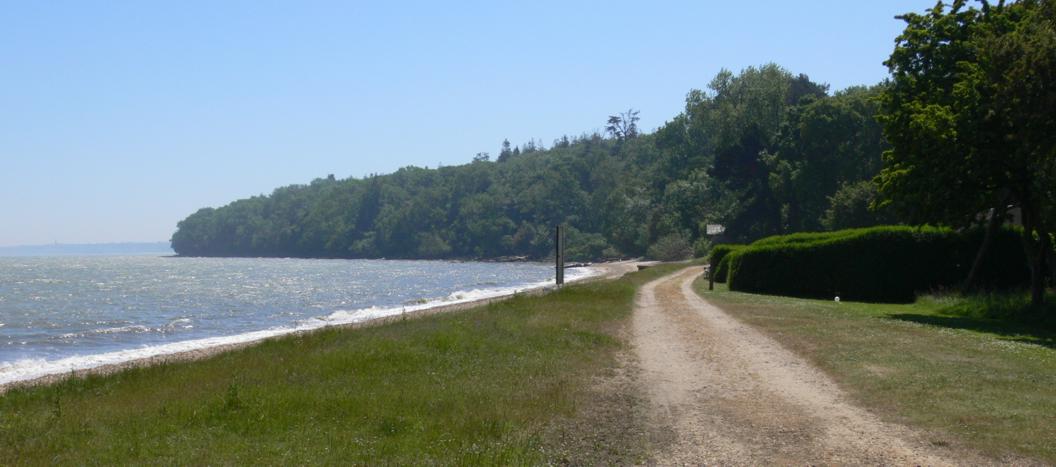A stroll by the beach
- Complaining about the Mainland - 17th August, 2024
- New island designation – is it just greenwash? - 26th April, 2024
- Police and Crime Commissioners – a solution or a problem? - 21st April, 2024
A few papers have picked up the latest development in Natural England’s mission to open up coastal access around England. Perhaps not surprisingly, news of the death of Bobby Robson and ‘blasphemous’ nudie photos in a church have taken a more prominent place in the headlines… but actually, this could be pretty important. Especially for the Isle of Wight and other English counties with long coastlines.

Natural England has now assessed existing coastal access, and published indicative maps showing what they think the situation is around England. This picture is an extract. So, what does it mean? Interestingly, the maps show that there is no ‘satisfactory or legally secure access’ to 34 per cent of the English coast. This means that nearly 1,000 miles of England’s coastline is inaccessible to the public. Still, that’s not actually that bad. About 2,000 miles is accessible, which would take you a while to walk. More significant is the fragmentation of the paths. The island map above shows this in practice. Clearly, there is very good coastal access on the Island, as you might expect in the place that hosts the UK’s largest walking festival, but compare the purple and green lines – there are long stretches where you can walk, but short breaks in the path means that the continuous path ends. You could say this kind of spoils the point of a coastal walk. Certainly this is an important principle for Natural England. Poul Christensen, Acting Chair of Natural England, said: “On average [around England] you cannot walk further than two miles without reaching an area of unsecure access or having to turn back.”

This issue of fragmentation raises two points. Firstly, how important is a continuous path, in fact? How many coastal walkers want to walk more than two miles (or four miles, if you include the return leg) in a session? I would suggest that the answer is proportionately very few. Natural England’s predecessor authority, the Countryside Agency, said in its 2003 document ‘Transport in tomorrow’s countryside‘ that the average length of what they termed a ‘walk journey’ is 0.5 miles in rural England, and 0.6 miles nationally. Now there certainly is a desire for long-distance path use, and indeed the use of long-distance paths has been a striking phenomenon which has become more significant as walking for leisure has increased at the expense of walking for other purposes. However there has always remained the question of whether long-distance walking is led by supply or demand. Making and promoting high-profile routes is a relatively easy and cheap thing to do compared with maintaining all the other rights of way, and concentrating people on ‘honey-pot’ routes can have a detrimental environmental impact. If there were no big, well-promoted and maintained pathways across the country, but instead a general improvement in all paths, would the people who use the major routes just go walking anyway, but perhaps make their own itineraries? Arguably the same could be said of the coast. If the demand is for many, short walking routes along the coast, then opening more coastal path would be a desirable thing certainly; but if the demand for long continuous walks is not so great, should defragmentation of the path be given such a high priority? Perhaps the resource would be better spent on improving the quality of the existing paths. Secondly, there is the law of diminishing returns. There is no doubt that resolving the complex and potentially controversial issues of coastal access will involve unknotting some very difficult issues. For example, the conflict between nature conservation and public access – most especially public access with dogs. There is also some very significant opposition from landowners and people who just don’t like Natural England – some hysterical, some reasonable. Leaving aside the rights and wrongs of the debate, the fact is that there will be expensive, lengthy and difficult battles over many of the areas where access is proposed. Some it will probably end up in court or maybe even before Parliament again. By attaching such importance to creating a continuous path, Natural England have made themselves a very big hostage to fortune. Any one landowner holding out could stymie the process – and goodness knows that there will be enough volunteers for that role. Even if the government has a legal power to enforce its will, as it should do, to use any such power is always expensive and slow compared with voluntary arrangements. Those negotiating on our behalf with landowners on behalf of the government have a big disadvantage: the landowners know exactly what they want. So as the process continues, the more difficult and expensive issues will keep on coming; and eventually, surely, the point will be reached where it really isn’t a good use of public money to pursue a continuous path at any cost. This isn’t to say a coastal right of access is a bad idea. It isn’t, in principle. But the time is approaching where principles have to be developed into actual proposals and detail. My belief is that the detail of this issue is going to prove to be a lot more tricky to unravel than the previous Access Land process.


